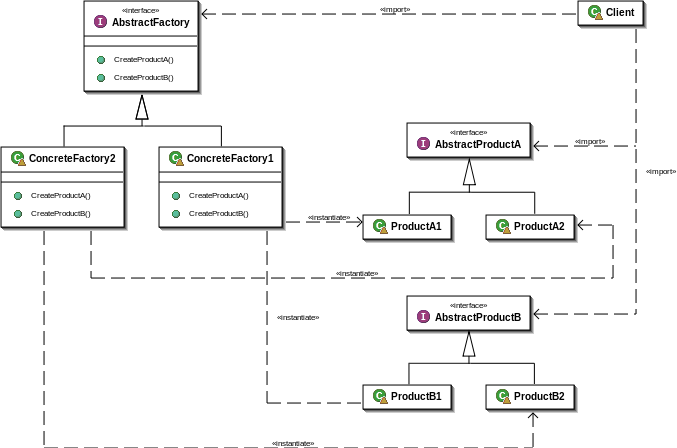The essence of the Abstract Factory Pattern is to "Provide an interface for creating families of related or dependent objects without specifying their concrete classes".
class diagram
uml diagram

1 /* GUIFactory example */
2
3 #include <iostream>
4
5 class Button {
6 public:
7 virtual void paint() = 0;
8 virtual ~Button() { }
9 };
10
11 class WinButton : public Button {
12 public:
13 void paint() {
14 std::cout << "I'm a WinButton";
15 }
16 };
17
18 class OSXButton : public Button {
19 public:
20 void paint() {
21 std::cout << "I'm an OSXButton";
22 }
23 };
24
25 class GUIFactory {
26 public:
27 virtual Button* createButton() = 0;
28 virtual ~GUIFactory() { }
29 };
30
31 class WinFactory : public GUIFactory {
32 public:
33 Button* createButton() {
34 return new WinButton();
35 }
36
37 ~WinFactory() { }
38 };
39
40 class OSXFactory : public GUIFactory {
41 public:
42 Button* createButton() {
43 return new OSXButton();
44 }
45
46 ~OSXFactory() { }
47 };
48
49 class Application {
50 public:
51 Application(GUIFactory* factory) {
52 Button* button = factory->createButton();
53 button->paint();
54 delete button;
55 delete factory;
56 }
57 };
58
59 GUIFactory* createOsSpecificFactory() {
60 int sys;
61 std::cout "\nEnter OS type (0: Windows, 1: MacOS X): ";
62 std::cin >> sys;
63
64 if (sys == 0) {
65 return new WinFactory();
66 } else {
67 return new OSXFactory();
68 }
69 }
70
71 int main() {
72 Application application(createOsSpecificFactory());
73 }
74
posted on 2012-11-13 16:46
老马驿站 阅读(404)
评论(0) 编辑 收藏 引用 所属分类:
Design pattern